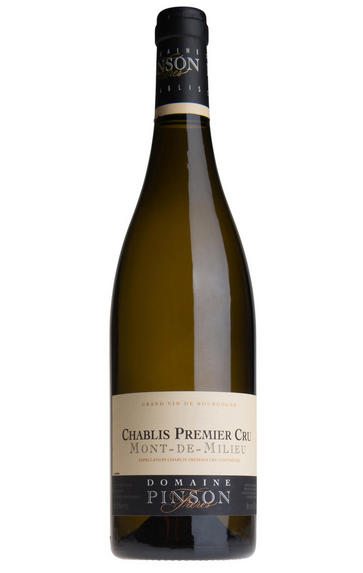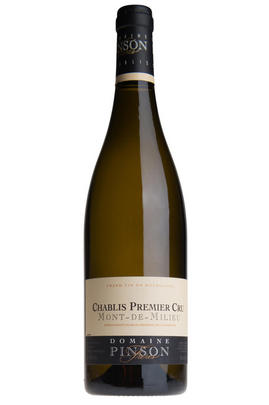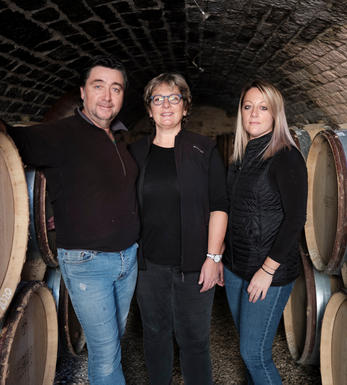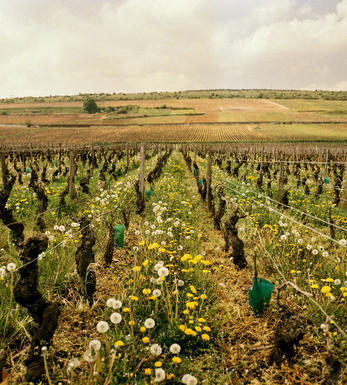
2013 Chablis, Mont-de-Milieu, 1er Cru, Domaine Pinson Frères, Burgundy

About this WINE

Domaine Pinson
The Pinson family have been growing grapes and making wine since 1640. They were among the first in Chablis to bottle their wines for public sale, in the 1880s. By 2009, the area under vine had grown to about 14 hectares, with holdings in Grand Cru, Premier Cru and village-level Chablis vineyards. The wines are made in the classic Chablis style while expressing the distinctive character of each terroir.
Domaine Pinson Frères has a fine range of vineyard sites, including four parcels in the Grand Cru Les Clos from which they make two different cuvées, and which allows them to combine the best features of the site.
The frères in the name are brothers Laurent and Christophe Pinson. Laurent's daughter Charlène has been winemaker here 2008, arriving with a degree in viticulture-and-winemaking from Beaune, and experience working in the Rhône. She has retained the traditions that have served the domaine well, using small amounts of new oak and mostly stainless steel, and has also introduced improvements in the cuverie, such as smaller tanks for more precise blending.
The domaine’s 14 hectares include holdings in Grand Cru (Les Clos), Premier Cru (Forêts, Fourchaume, Vaillons, Mont de Milieu, Montmains and Vaugiraut) and about two hectares of village Chablis. The estate’s plots on the left bank of the Serein River have Kimmeridgian soils rich in marine calcium and marl. On the right bank, soils are rich in calcium but with more clay, favouring a slightly richer style of wine. No weedkillers or insecticides are used, and yields are strictly controlled.
The Grand Cru and Premier Cru wines are fermented in 10-20% new oak, with the balance in stainless steel, and matured in older oak barrels. The village-level Chablis is fermented and aged entirely in stainless steel.

Chablis Premier Cru
Chablis Premiers Crus are stylish, minerally wines which, typically, are less intense than the Grand Crus but finer and longer-lasting than basic Chablis. They are highly underrated with the better examples outclassing many a good village white Burgundy.
The vineyards cover 750 hectares, scattered across 15 communes on isolated slopes with good exposure. There are 17 principal Premiers Crus but in total 79 vineyards are eligible, with most of the lesser-known ones using a more familiar umbrella name on their label. The best flank the Grands Crus on the north bank of the River Serein, like Montée de Tonnerre (probably the best of all), Fourchaume and Mont de Milieu.
Those just south of Chablis, like Vaillons, Montmains (especially Les Forêts) and Côte de Léchet are also good. With the vineyard area having doubled since the 1970s, quality varies enormously so, as ever, the producer is key.
Styles also vary, with some maturing and fermenting in stainless steel for a purer, more minerally style, while others age and sometimes even ferment their wines in oak for extra complexity. The best examples reach their apogee at eight to 10 years, but are normally enjoyed long before then.
Recommended producers: Jean-Claude Bessin, Billaud-Simon, Séguinot-Bordet, J.-P. & Benoit Droin, Duplessis, Defaix

Chardonnay
Chardonnay is often seen as the king of white wine grapes and one of the most widely planted in the world It is suited to a wide variety of soils, though it excels in soils with a high limestone content as found in Champagne, Chablis, and the Côte D`Or.
Burgundy is Chardonnay's spiritual home and the best White Burgundies are dry, rich, honeyed wines with marvellous poise, elegance and balance. They are unquestionably the finest dry white wines in the world. Chardonnay plays a crucial role in the Champagne blend, providing structure and finesse, and is the sole grape in Blanc de Blancs.
It is quantitatively important in California and Australia, is widely planted in Chile and South Africa, and is the second most widely planted grape in New Zealand. In warm climates Chardonnay has a tendency to develop very high sugar levels during the final stages of ripening and this can occur at the expense of acidity. Late picking is a common problem and can result in blowsy and flabby wines that lack structure and definition.
Recently in the New World, we have seen a move towards more elegant, better- balanced and less oak-driven Chardonnays, and this is to be welcomed.


Buying options
Add to wishlist
Description
Decanter World Wine Awards 2015 – Bronze Medal Winner - Chablis Wine
Beautiful bright, pale colour with a marvellously heady nose, picked before the rain. Complete and totally adorable with a magical thread of mineral acidity running through it. Really brilliant for Premier Cru Chablis. Drink 2016 - 2022+
Jasper Morris, MW - Wine Buyer
Taking advantage of its southerly exposure, Mont de Mileu can produce richer styles of Chablis often associated with that of Grand Cru wines. Here is an overt bouquet, expressing aromas of red apple skin, white peach & orange blossom. The palate is generously textured with a wealth of stone fruit, red apples and flicks of sweet oak. A lovely taught acidity underpins this to provide balance and retains freshness leading to a mouth-watering finish.
Chris Lamb, Private Account Manager
The Pinson family can trace their history in Chablis back to 1640, there is even a Rue Pinson in the town so named because three Pinson brothers lived in identical houses in the street.
Louis Pinson sold his first bottles in 1880 but the domaine is now in the hands of his Great Grand-Daughter alongside her Father and Uncle. Highly regarded and meticulously managed, everything is hand-harvested and the grapes are sorted both in the vineyard and at the winery. Fermentation is mostly in stainless steel using selected yeasts before being transferred to barrels to mature.
Mont de Milieu is their largest holding but they also have vines in the 1er Crus of Forêt, Fourchaume, Montmains and Vaillon as well as the Grand Cru Les Clos.
wine at a glance
Delivery and quality guarantee